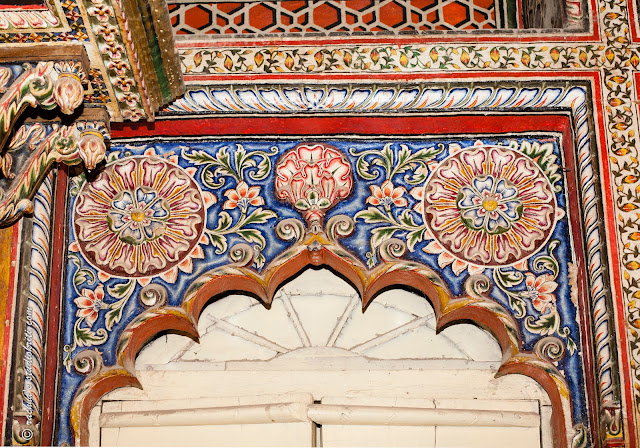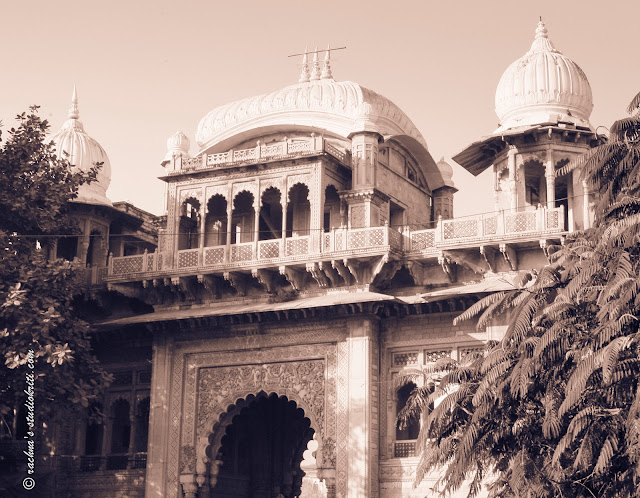Jayaji Rao Scindia who succeeded the short rule of Jankoji Rao Scindia, was only 8 years old when he was made the official king, in 1843. He ruled Gwalior for a relatively long period of 43 years, till 1886. During this period he built most of the modern day Gwalior, and those buildings are, not only present, but are being used in various ways even today. Jayaji Rao maintained friendly relationship with British and used the bargained peace to develop his city.
The first palace he made is Moti Mahal, a mansion with nine hundred rooms. It draws inspiration from the medieval buildings in Gwalior and has an oriental ambience with terraces flanked by square towers. The reflection of the palace looks beautiful on the artificial lake on the front. Later, Maharaja Madhavrao Scindia converted it into secretariat of Gwalior Riyasat. It was known as "Huzoor Secretariat". The palace features mosaic work of colored glass and gold leafing, and murals depicting Ragas and Raginis. The palace also has a rich collection of wall paintings. The palace is used as a number of State Administrative offices today.
Durbar Hall
Everyday Sarkari Office amidst Heritage Art
The Magnificent Great Room now used as Another Conference Hall
Amazingly beautiful Music Room, covered with wooden panels with very intricate miniature paintings all over, depicting life and times of Scindias in Gwalior
Later he made a much more magnificent palace, with heavy European influence on architecture, the Jai Vilas Palace, that is functional even today. Part of this palace serve as residences of various Scindia family members and part of it is converted into a museum maintained by Scindia trust. The museum has a medley of furniture and objects used by the multiple generations of Scindias, quite a few gifts received from British and other European royalties, and an unapologetic display of tens of stuffed tigers as royal hunting trophies.
Other than palaces, Jayaji Rao made multiple prominent buildings in various archetectural styles, to develop the town center, including comomorative Gates, administrative buildings, inns etc. He also made a number of temples around the town.
The Regal Theatre
The Gorkhi Gate
The Victoria Market
Now burnt down by an accidental Fire!
Krishna Temple at Gorkhi
Many of these beautiful heritage monuments and buildings are ridden with modern day thoughtless ugliness. Is it not possible to be mindful of putting hideous objects next to them and ruin their beauty. Is it not possible to clean and develop beautiful parks around some of such commemorative Gates for example, and may be even lease them out to cafes and restaurants, to earn some profit to maintain them. if such buildings are made part of people's everyday life, they will get much more value and love from common people.
Gate of the inn "Duffrin Sarai"








































THE PHOTOS SHOW THE KEEN EYE OF MS RACHANA ON ART AND CULTURE. IT IS THE TIME THAT ALL HERITAGE BUILDINGS AND GATES SHALL BE TAKEN OVER BY GOVT AND LEASE THEM TO SUITABLE ORGANIZATIONS FOR PROPER UPKEEP AND MAINTENANCE. INSTEAD OF DESTROYING THE BEAUTY BY URGLY WIRES AND ELECTRICAL INSTALLATIONS, THESE BUILDINGS MAY BE LEASED TO PVT PARTIES FOR CHARGING NOMINAL FEE FROM TOURISTS AND KEEP THE SURROUNDINGS KEEP CLEAN TIDY AND ENJOYBLE.
ReplyDeleteI THANK MS RACHANA FOR UNVEILING THE BEAUTY OF THE HERITAGE STRUCTURES. MAY GOD BLESS HER.
What a revelation - thank you. It is such a shame that what ought to have been preserved as a heritage museum got converted to office space.
ReplyDeleteGwalior ought to rank up there as a world class tourist destination with all that it has to offer. But it will take a little aesthetic cleansing, (as you rightly note).